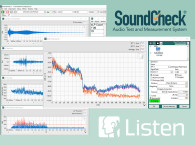
SoundCheck Version 22 (2024) expands on the leading features that made the Listen software a leading choice for production line testing. This update responds to actual market requirements with Python integration, sequence versioning, more powerful metadata options and enhanced statistics functionality. R&D users also see a capability-boost with crest factor analysis, new post-processing functionality and upgraded virtual instruments.
The new Python custom step module ((optional module #2042) enables users to call custom Python functions from a SoundCheck sequence. This makes it easy to pass data and variables between SoundCheck and other devices or programs. Applications include sending custom commands to put a device into diagnostic mode or playing a test signal from a device. It also enables communication with custom databases, and passing directional measurements to programs such as VACS and EASE for balloon analysis. Users can also call MATLAB functions via Python for automated MATLAB analysis of SoundCheck measurements. The Python custom step module avoids requiring LabVIEW to integrate with other programs, simplifying programming and maintenance.
A strong reason to upgrade immediately is the new Crest Factor Analysis algorithm, which is a technique that measures peak-to-RMS ratio to evaluate impulsive distortion and analyze the dynamic range of real signals. It complements SoundCheck's unique enhanced Loose Particle algorithm - introduced in Version 21 - for transient distortion measurement and enables comparison of the two methods using the same measured data. Crest factor can be calculated and displayed via a multimeter on the input signal path as well as in the analysis step.

SoundCheck 22 also introduces a new Sequence Versioning functionality that makes it easy to track changes made to a sequence and ensure that colleagues and contract manufacturers are using the correct version. Comment fields make it easy to document changes, and the sequence history view provides a log of historical changes. Archiving functionality allows the sequence to be backed up while it is being developed, so changes can easily be rolled back while retaining the versioning information.
The Statistics Module is completely overhauled with additional functionality and an updated interface for easier use in SoundCheck 22. A new layout makes data selection easier, and curves, values, and results can now simply be dragged and dropped from the memory list into the statistics editor. A new ‘Reset Statistics’ step allows statistics to be reset during a sequence. This is useful when applying statistical analysis to data from a sequence loop or a fixed number of measurements, as the statistics data and sample count can be automatically cleared, ready for the next measurement once the desired settings have been reached. Enhanced searching, including meta-data, makes it easy to select groups of curves from the memory list, and it is now even possible to specify a frequency range within which to run statistics.
There are also powerful new Post-Processing Tools that expand SoundCheck's calculation capabilities and simplify complex applications. These include Logarithm and Exponent calculation using base 2, 10, or custom values; Leq (equivalent continuous sound level) versus Time option for use in noise monitoring, communications applications, and many standards; New ‘Intersection Modes’ option for greater specificity in the choice of finding intersection points; And an option to ignore units in arithmetic and constant post-processing. This facilitates simple mathematical calculations, for example, quickly subtracting a fixed number of dB to correct sound level from the near field to the far field. There's also a 'Cosine Taper’ custom window in post-processing FFT which allows leading and trailing taper widths to be customized. This is useful for time-windowed measurements.
Metadata functionality in SoundCheck 22 includes new options, as well as increased flexibility for metadata entry. New system metadata options include SoundCheck version, sequence version, start and save date and time. Metadata can now be applied either during the run of a sequence or appended at the end, and the metadata may be applied to either a single measurement or a batch of measurements. It is easy to identify results by metadata as this can now be searched in the memory list, and the metadata of any selected curve can be displayed simply by selecting it in a display window.

The upgraded Signal Generator and Multimeter offer enhanced support for accelerometers and shakers in applications where haptic, or both acoustic and haptic, measurements need to be made. These include fan noise measurements, vibrating car seats, and MEMS microphone/accelerometer combinations. Acceleration units can now be calibrated in g as well as m/s², and offer the option to integrate acceleration to velocity in the multimeter.
The signal generator now allows maximum and minimum output levels and frequencies to be set. This limits the range of the signal path to help prevent accidental equipment damage. These levels are retained when the configuration is saved or used in a sequence, but levels can still be manually adjusted within these ranges. Waveforms can now be played back at their original recorded level with no gain applied. This is useful for listening tests.

Multi-Instrument Enhancements in SoundCheck 22 include the addition of a multi-channel FFT analyzer, multiple detachable display windows, and the ability to implement calculation across live and stored curves. A single multi-instrument can have multiple simultaneous display windows, and these are now detached from the control panel, and can be re-sized and re-positioned for unlimited desktop layout flexibility.
Finally, SoundCheck 22 offers significant performance advantages when running on Apple Mac computers with Apple Silicon (M-Series) processors.
Listen is promoting upgrades to SoundCheck 22 with discounts up to 56% until the end of June 2024, including packages with the new optional Python Custom Step module (+$525).
www.listeninc.com







